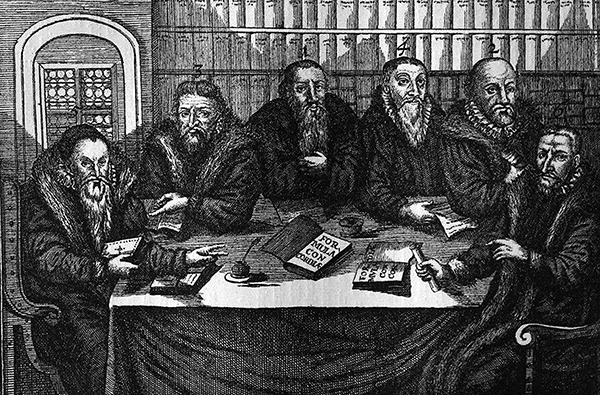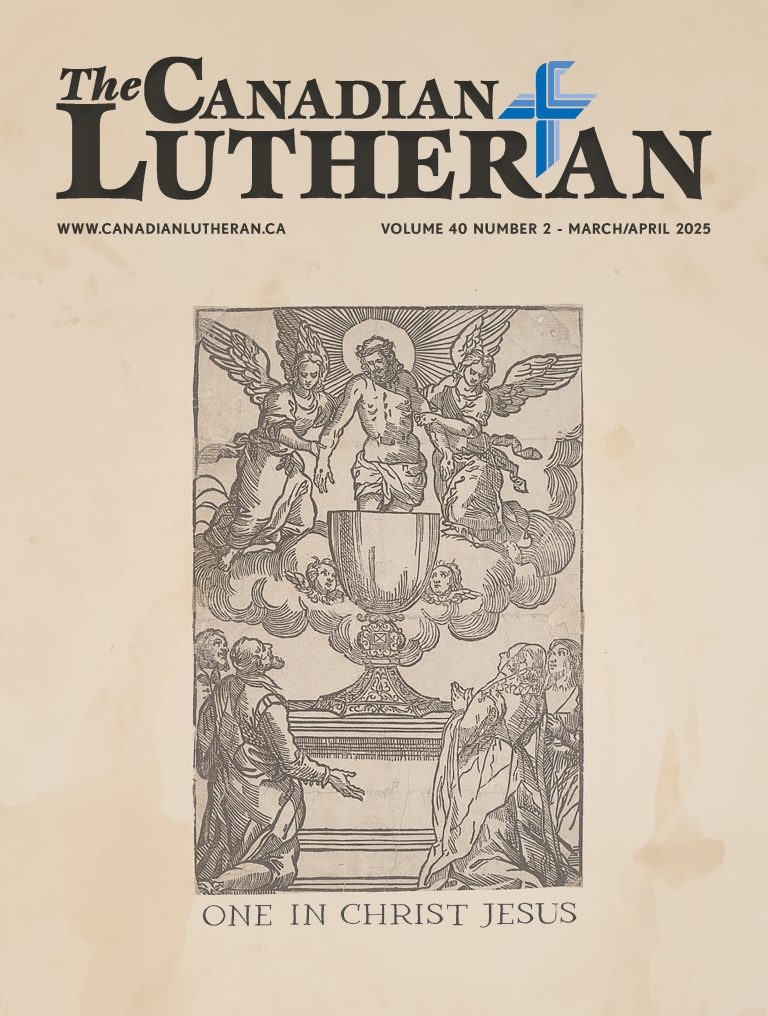History of the Reformation: Lutheranism After Luther

The writers of the Formula of Concord (19th century illustration).
by Mathew Block
The publication of the Augsburg Confession in 1530 may have solidified the Lutheran tradition, but the troubles for the Reformation did not end there.
War seemed inevitable. Emperor Charles V had already tried diplomatic means at Augsburg to force the Lutheran princes to return to Roman faith and practice. The sword would undoubtedly be next.
For this reason, the Schmalkaldic League was formed in February 1531. The League was envisioned as a defensive alliance for the Lutheran princes, protecting each other if the Emperor should attack one of them
For several years the League’s resolve was not put to the test: Charles V was distracted with wars elsewhere, especially against the Ottoman Empire. In the meantime, the princes encouraged the spread of the Lutheran Reformation in their lands.
A 1537 meeting of the League planned to consider a new confession of faith—the Smalcald Articles—prepared by Martin Luther. But Luther fell ill and the League never formally adopted the document at the time, though later Lutherans would accept it as a statement of faith.
Luther’s health was a source of increasing difficulty as the years went on. He suffered from kidney stones, arthritis, cataracts, vertigo, fainting, and more.
The final struggle came in 1546. Luther was in Eisenach, the city of his birth, when he began to experience severe chest pain the morning of February 17, and recognized that his death was imminent. Asked if he would die “trusting in the Lord Jesus Christ” and confessing the doctrine he had taught, Luther replied clearly: “Yes.” He suffered a stroke and died early in the morning of February 18, 1546. His final writings ended with simple words: “We are beggars. This is true.”—a reference to our reliance on Christ Alone for salvation.
Luther’s final writings ended with simple words: “We are beggars. This is true.”—a reference to our reliance on Christ Alone for salvation.
Just six months after Luther’s death, war between Charles V and the Lutheran princes finally broke out. Charles V, having recently won the Italian War, was feared to be preparing for battle against the Lutherans. The Schmalkaldic League decided to act first, occupying the Catholic town of Füssen in July 1546. The Emperor’s forces soon entered the fray. Over the next year, the Lutherans failed to maintain a consistent military strategy, eventually leading to their defeat in April 1547 at the Battle of Mühlberg.
On May 15, Charles V issued the Augsburg Interim, which ordered the Lutheran territories to return to Roman teachings and practices: seven sacraments, transubstantiation, and papal authority, for example. The Interim also contained several concessions to the Lutheran positions—namely in allowing the laity to receive both the bread and wine during communion, as well as allowing clergy to marry. Even so, the Lutherans protested. Approximately 400 pastors were imprisoned for failing to abide by the Interim’s requirements while some fled to other countries. Others were executed.
To foster peace, Philip Melanchthon worked with the Emperor’s representatives on a document more palatable to the Lutherans. That document, the Leipzig Interim, attempted to carve out space for Lutherans to continue to teach justification by grace through faith and other essential doctrines, while showing flexibility in some areas the authors considered “adiophora” (ie, unessential matters not touching doctrine).
The trouble was, not all Lutherans agreed on what was and was not adiophora. Matthias Flacius led a movement accusing Melanchthon of heresy. The so-called Gnesio-Lutherans and Philippists would come to be bitter opponents.
The occasion of these disagreements—the Augsburg and Leipzig Interims—came to an end in 1555 with the signing of the Peace of Augsburg. The treaty officially gave Lutherans legal status in the Holy Roman Empire, and followed a 1552 revolt by the Lutheran princes against the Emperor—a conflict which the Lutherans had won. The Peace of Augsburg declared that the religion of any given territory would be that of its prince, whether Lutheran or Roman Catholic. As for the common people, should they wish to move to a territory aligned with their own religious beliefs, they were not to be hindered. The Lutheran tradition was now legally recognized.
But inter-Lutheran debates and argumentation would continue for many years to come. Melanchthon, at his death in 1560, comforted himself with the knowledge that he would soon be “delivered from sins, and be freed from the acrimony and fury of theologians.”
Such divisions would last until 1577 and the publication of the Formula of Concord. Composed primarily by Martin Chemnitz and Jakob Andreä, the work brought to a close many of the disagreements present among German Lutherans.
Three years later, the Lutheran Confessions were finally collected and published together in The Book of Concord. The book contains the Apostles’ Creed, the Nicene Creed, and the Athanasian Creed. It also includes three works by Philip Melanchthon (the Augsburg Confession, the Apology of the Augsburg Confession, and the Treatise on the Power and Primacy of the Pope) and three works by Martin Luther (the Small Catechism, the Large Catechism, and the Smalcald Articles). The Formula of Concord appeared last.
Over the centuries, Lutherans have faced—and, regrettably, sometimes instigated—conflict and persecution. On these things we look with sorrow. But greater still is our joy for the things God accomplished through the Reformation.
Troubles for Lutherans were not over, of course. Over the centuries, Lutherans have faced—and, regrettably, sometimes instigated—conflict and persecution. On these things we look with sorrow. But greater still is our joy for the things God accomplished through the Reformation. In particular, the Book of Concord is a treasure for all Christians, one that our churches do well to defend. For in the end, it teaches—as the Scriptures teach—the pure Gospel of our Lord Jesus Christ: that we sinful human beings are saved by grace alone through faith alone in Christ alone.
———————
Mathew Block is former communications manager of Lutheran Church–Canada (LCC) and former editor of The Canadian Lutheran magazine. He is also editor of the book Saints of the Reformation, published by LCC to mark the 500th anniversary of the Reformation.
This is part six in a six-part series on the History of the Reformation. Find all the currently published articles here.




